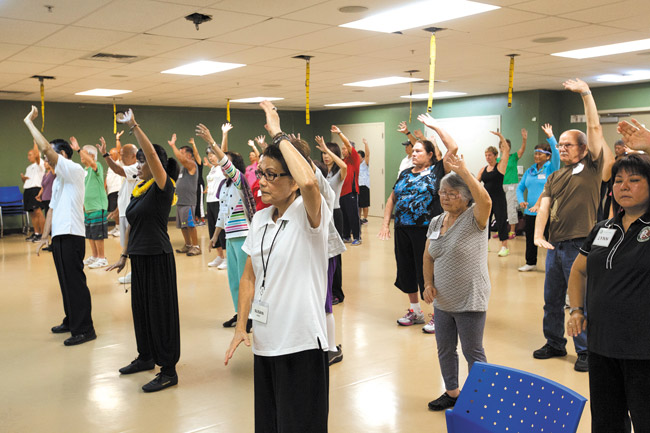Hawaii’s Falling Epidemic
Hawaii averages 85 seniors (65 and older) who die in falls every year. Another 1,960 are hospitalized after falls, and 8,700 receive medical treatment. With baby boomers aging, the risks increase. But falls can be prevented. Here’s how
Chances are, you know a kupuna who has been critically injured or has died from falling. Each year, according to the state Department of Health, 85 seniors (ages 65 and older) in Hawaii die, 1,960 more are hospitalized and an astounding 8,700 are treated by emergency services ― all as a result of falls. And these figures are conservative.
The numbers would be 30 percent to 50 percent higher, except that some fatal falls are listed under competing diagnoses, says Dan Galanis, epidemiologist for the Department of Health’s Injury Prevention Program. In keeping with Centers for Disease Control protocol, even if someone has sustained injury or death from a fall, existing chronic diseases like diabetes or dementia are generally listed as the principal diagnosis.
Calling the problem an epidemic isn’t a stretch, and the monetary cost is tremendous too, carrying a price tag of nearly $120 million in yearly hospital and physician charges. Additional statistics highlight the gravity of the problem, particularly with Hawaii facing an increasingly aging population. In Hawaii’s overall population in the past five years, 685 people have died from falls, surpassing even motor vehicle deaths, and remaining second only to drug poisoning as a source of fatal injuries. Ratcheting up that figure are senior falls.
“The bulk is senior falls,” notes Galanis. “Kids fall while running with things, they go to the emergency department and are generally fine. A similar sort of fall or impact for seniors has much greater implications in terms of recovery.”
Galanis says a “constellation of risk factors” contribute to senior falls, making preventative measures complex. Those factors include diminishing balance, strength, vision and physical resiliency. Paired with environmental situations that might readily cause a person to trip ― shoes that aren’t supportive, uneven or steep ground, wires or carpets, and dim lighting ― the result can be dangerous if not lethal.
To improve matters, the DOH organized a May-through-July campaign with a collaboration of parties, called the Hawaii Fall Prevention Consortium. With the aim of bringing awareness to caregivers, doctors and family members, the campaign has included AARP prevention programs, posters on buses, pharmacy departments giving out fall prevention tips and reviewing medications that might contribute to falls, TV public service broadcasts, a new DOH website (nogethurt.hawaii.gov), and tai chi workshops. The campaign is proving so important as an intervention tool, DOH plans to make it an annual thing.
One of the groups with a hand in the consortium and taking part in the campaign is Kaiser Permanente. Dr. Anthea Wang, an internal medicine physician at Kaiser and medical director of Kaiser Honolulu’s Medicare and Medicaid programs, points out some real-life cases of senior citizens who are at risk and what she does to help them.
“I worry about my women a lot more than the men,” she says. “Women live longer, so there are a lot more 90-something-year-old women who are often more frail because of their size, and they’re more prone to osteoporosis. A majority of falls result in a hip fracture.”
Surgery after the hip fracture can easily lead to complications. Healing takes longer than it once did, and elderly patients are more prone to cardiovascular and stroke complications from surgery, or to a pulmonary embolus or lethal blood clot.
As a way of addressing some of the major issues involved in falls and fall prevention, Wang describes three female patients in their 90s.
“Melissa”
Problem: Melissa, a petite woman, lives alone, and has 20 stairs to climb to her house. While the activity keeps Melissa physically fit, Wang worries about her falling. Melissa does not have family to look out for her as they live on the Mainland, and she has no desire to leave Hawaii.
Solution: Wang stresses always carrying a cell phone or making use of an emergency response bracelet or necklace such as Life Alert. That way, if Melissa falls and is injured, she can push a button to call for help. Melissa brought a friend to her last visit, and Wang encouraged Melissa to give the friend a key to her house and to have the friend call and check on her every day.
“Patty”
Problem: While Patty has a son who lives with her, she has a cane to aid her balance, but rarely uses it. She doesn’t like the loss of independence that she feels when using a cane in public, and she’s so familiar with home that she chooses not to use it there.
But, says Wang, familiarity breeds carelessness.
“Loss of independence is frustrating for the patient, especially when it involves doing things they’re so used to doing,” says Wang. “They think about themselves as a different age than they really are, so they don’t want to use a cane. But if you fall, it’s a dramatic loss to independence. Prevention is key.”
Solution: To prevent falls, Wang talks with Patty and her son about home safety. The son has installed bars in the bathroom and hallway, and he’s made sure there are no rugs in the house that Patty might trip on. He has checked to ensure the rooms are well lit, and he installed night lights throughout the house.
“Katie”
Problem: Katie’s daughter lives with her, and a caregiver is also on hand, but Katie hasn’t been active. She is still self-sufficient, but while she used to play piano and crochet, her days now consist of only eating, sleeping and watching TV. She has back pain, but doesn’t do the exercises that Wang gives her.
Solution: Wang talked with Katie about going to physical therapy to help her maintain balance. Physical therapists can determine if a cane would be appropriate and whether one prong is sufficient or whether a three-prong cane will provide the needed stability. They’ll also adjust it to the proper height and teach the patient how to use it. Additionally, Wang encouraged Katie to get involved in a senior center where she can get exercise and socialization while participating in programs at the center a few days a week.
“The key is to keep moving or weight goes up, you feel a lack of energy and you become de-conditioned,” says Wang.
Wang also emphasizes the DOH’s four key precautions against falls:
* Review medications. Check with a doctor or pharmacist about your regimen of medicines, including over-the-counter medications and supplements. Medications like cold medicines and antihistamines can cause drowsiness and affect balance.
* Schedule regular vision and hearing check-ups. Small changes can affect stability.
* Make the home safe. Remove tripping hazards and increase visibility around you. Remove rugs and clutter. Repair loose carpets and uneven floors. Do not wear socks on wood floors. Wear properly fitted shoes (not slippers) with good supports.
* Stay active. Regular physical activity increases strength, flexibility and balance.
“At Kaiser Permanente, our clinical pharmacy, eye, audiology, physical therapy and health education departments work together with our primary care doctors to help our senior members prevent falls and fall-related injuries,” notes Wang.
Measures taken at Kaiser include comprehensive medication reviews by a clinical pharmacist, regular eye checkups, gait and balance evaluations and training by physical therapists, and a variety of classes, such as chairobics, yoga, tai chi, and osteoporosis and fall prevention.
“Senior health is really about embracing life as we age,” says Wang. “Our lifestyle choices and outlook on life have a great influence on our health. Preventing falls by taking simple proactive steps is an essential part of healthy aging.”







